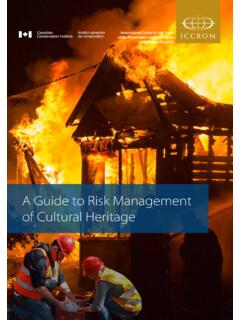Transcription of CULTURE AND LOCAL DEVELOPMENT - OECD
1 CULTURE and LOCAL DEVELOPMENT . Visit our website: Background document Follow us on Twitter: @ OECD_local #OECD CULTURE About the OECD. The OECD is a unique forum where governments work together to address the economic, social and environmental challenges of globalisation. The OECD is also at the forefront of efforts to understand and to help governments respond to new developments and concerns, such as corporate governance, the information economy and the challenges of an ageing population. The Organisation provides a setting where governments can compare policy experiences, seek answers to common problems, identify good practice and work to co-ordinate domestic and international policies.
2 This paper is published under the responsibility of the Secretary-General of the OECD. The opinions expressed and the arguments employed herein do not necessarily reflect the official views of OECD. member countries. Find out more about OECD work on this topic: OECD 2018 You can copy, download or print OECD content for your own use, and you can include excerpts from OECD publications, databases and multimedia products in your own documents, presentations, blogs, websites and teaching materials, provided that suitable acknowledgment of OECD as source and copyright owner is given.
3 All requests for commercial use and translation rights should be submitted to CULTURE AND LOCAL . DEVELOPMENT . Background document TABLE OF CONTENTS 3. Table of contents 5. A new environment .. 5. How can CULTURE contribute to LOCAL DEVELOPMENT ? Two perspectives .. 6. The role of LOCAL government in promoting CULTURE as a lever for DEVELOPMENT .. 7. Acknowledgements .. 9. Chapter 1. How to define CULTURE ? .. 11. Non-industrial (core) cultural sectors .. 13. Cultural and Creative 14. Digital content platforms .. 15. What are the benefits of CULTURE ? .. 16.
4 Chapter 2. Why CULTURE matters for LOCAL DEVELOPMENT ?.. 21. The case of arts, crafts and design for LOCAL DEVELOPMENT .. 22. The role of CULTURE in urban regeneration .. 25. The role of CULTURE in rural regions: common challenges, different 26. Chapter 3. How can LOCAL governments promote CULTURE ? .. 27. A new public management for CULTURE .. 29. Managing cultural landscapes for creativity .. 34. How to evaluate the impact of cultural projects? .. 39. Chapter 4. How to finance the cultural sector? .. 43. The traditional public financing system .. 44. Using markets to finance CULTURE .
5 45. Philanthropy .. 46. Crowdfunding, Crossovers and Citizen Engagement .. 47. Chapter 5. A framework for creating capacities at the LOCAL level .. 51. Annex A. Data definitions .. 55. CULTURE AND LOCAL DEVELOPMENT . OVERVIEW 5. Overview A new environment There has been a growing interest in the role played by cultural activities in LOCAL DEVELOPMENT . When major traditional industries declined or disappeared at the end of the last century, cultural tourism and creative industries have been recognised as both a heritage and a lever for future DEVELOPMENT .
6 Central and LOCAL governments were mandated to develop infrastructures for cultural creation and heritage conservation, to widen the accessibility to cultural goods and services, and to ensure that CULTURE reinforces the image of their territories. These objectives remain valid, but the context has evolved, influenced by several trends. Digitalisation Digitalisation is making it possible to circulate content independently from the support used and by technically making cultural goods through algorithms. Digitalisation has revolutionised both the economy of CULTURE and the relation to CULTURE .
7 Digitalisation develops a new economy of cultural production based on data transmission and processing, this is a new cultural consumption that escapes the traditional constraints of space and time; and, includes new modes of sharing and feedback in the valuation of cultural goods. From the age of the work of art . succeeds an age of remix that questions intellectual property rights, promotes use rather than possession and makes CULTURE "a common good" consumed and produced by everybody. Globalisation In the past traditional cultural events were linked to a specific area or encapsulated inside some closed boxes, cultural algorithms now circulate at a high speed for ever-decreasing access costs.
8 We are currently witnessing the coexistence of two drivers of cultural activities. The global drivers transcend non-technological barriers and produce huge economic movements. The LOCAL drivers still rest on a direct link or a close relationship between the creators and their audiences. The production of books and movies have shown that CULTURE can be an industry. This is now true for all kinds of cultural goods. Given the existence of a LOCAL heritage and identity, CULTURE has become a "niche" to stimulate the demands all over the global economy, as well as to produce it from cultural districts.
9 The intrinsic and instrumental values of CULTURE CULTURE has increasingly cooperated with other services such as education, health, employment and welfare. CULTURE is recognised for both its intrinsic value and its instrumental value. The intrinsic value of CULTURE relates to the ability for people to know themselves better and understand each other better. The instrumental value of CULTURE relates to its contribution to the quality of life in many of its components. At the age of creative society, the quality of CULTURE helps making people reflexive and creative.
10 Undoubtedly, this is a specific form of creativity, based on curiosity and imagination. This artistically based creativity differs from the scientific-based creativity; its process is more horizontal, it does not result CULTURE AND LOCAL DEVELOPMENT . 6 OVERVIEW. from a process of trial & errors but from a process of exploration and reflexivity. The top-down logic of the traditional welfare state can face difficulties to integrate a turbulent cultural demand based on LOCAL proximity, partnership, remix and bifurcations. New conditions on the cultural goods market In parallel with the effects on the consumption of cultural goods, the same elements lead to new conditions in the production of cultural goods.
















